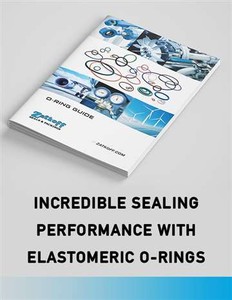Incredible Sealing with Elastomeric O-Rings
Featured Product from Zatkoff Seals & Packings

Traditional O-ring seals were made of natural rubber, which limited usage to water and other fluids that do not deteriorate rubber. DuPont's “Neoprene” of the 1930s and Standard Oil Co. of New Jersey’s buna process of the 1940s advanced the sealing capacity of O-rings when they introduced oil-resistant elastomers that could be made into viable compounds for a wide range of uses.
- Today’s O-ring is the result of experimental work conducted by Nils Christensen in the early 1930s that resulted in a patent in 1939.
- In the early 1940s, the O-ring became the standard seal for U.S. Air Force hydraulic systems, which established the standards for O-ring sizes and design.
- In the 1950s, the O-ring was accepted across a variety of applications, including industrial hydraulics, plumbing, appliance, pumps, valves, and other devices.
- Today, there are billions of O-rings that are widely used globally for sealing applications, in a wide variety of industries, including aerospace, automotive, industrial, life sciences, military, recreational, and more.
Given the technological advancements in recent years, many useful elastomers, or polymers, have since been developed that satisfy even higher operating conditions. Today’s O-ring compounds offer better chemical and physical properties, allowing them to withstand higher pressures and higher temperatures, with incredible resistance to numerous fluids.
Due to its affordability, ease of installation, and small space requirements, the O-ring is historically known as the most widely adapted sealing solution. Known for their durability and versatility, O-rings are suitable for dynamic or static applications with a wide range of temperature requirements.
Elastomeric rubbers, both natural and synthetic, are engineered materials that share common characteristics, such as elastic recovery after the application of stress (either compression or elongation), flexibility, extrusion resistance, and relative impermeability to liquids and gases. There are currently more than 20 “classes” of elastomers, each of which is characterized by its own unique properties and performance characteristics. Vulcanization chemistry and the inclusion of other ingredients can modify both.
Elastomer products are formulated to afford specific engineering properties for well-defined end-use applications, which is achieved by blending additives mechanically with the base elastomer. A typical elastomer compound may contain the following:
- The elastomer or polymer
- Curing agents
- Accelerators that aid in controlling the time required for vulcanization
- Activators that aid in increasing the rate of vulcanization by activating the accelerators
- Retarding agents
- Inert fillers, such as carbon black that reinforce and reduce cost
- Reinforcing agents
- Process aids, such as plasticizers that also improve flex and low temperature performance
- Special additives, such as colorants, flame retardant, etc.
Elastomer products are manufactured by curing, known as vulcanization, which is the process that converts the elastomer from a thermoplastic mass into a thermoset shape. Reactions occur whereby cross-links, or chemical bonds, are formed among the polymer chains that comprise the base elastomer(s). These cross-links impact the “elastic” characteristics of the elastomer product.



